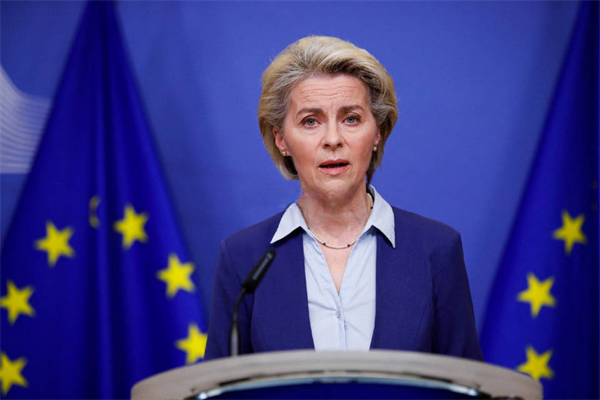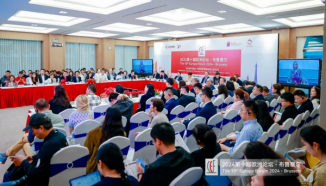The CCCEU Weekly Update May 19, 2023: Von der Leyen stated EU’s policy adjustment towards China


EU's Spring 2023 Economic Forecast highlighted the risk of inflation
Editor's Note: Greetings! Von der Leyen stated EU's policy adjustment towards China at Session III of the G7, proposing five strands of future work. This edition of the CCCEU Weekly Update keeps you informed of Spring 2023 Economic Forecast released by the European Commission, in which the inflation risk has been highlighted. Enjoy reading and have a nice weekend.
▶︎ Focus
On May 15th, the European Commission released the Spring 2023 Economic Forecast report, which, titled An Improved Outlook amid Persistent Challenges, presents a relatively optimistic economic outlook. It highlights that lower energy prices, abating supply constraints and a strong labor market supported moderate growth in the first quarter of 2023, dispelling fears of a recession, as a better-than-expected to this year. According to the forecast of key macroeconomic indicators for 2023 and 2024 respectively, the GDP growth rate is estimated upward to 1.0% and 1.7%; the inflation rate, upward to 6.7% and 3.1%; the EU aggregate government deficit as a percentage of GDP, downward to 3.1% and 2.4%; the unemployment rate, downward to 6.2% and 6.1%.
Decline in energy prices, while core inflation rate remains high.
Since reaching a peak of nearly $120 per barrel in mid-2022, oil prices have fallen. Although there was a short-lived uptick following the announcement of supply cuts by OPEC+ in early April, spot prices have since retreated to around $80 per barrel by the end of April. The outlook suggests further downward trends in oil prices, although the market remains uncertain. While measures such as the embargo on petroleum products and the G7+ oil price cap appear to have had the intended impact of lowering prices for Russian oil, the recovery of global demand, particularly in China, will likely be a key factor affecting the evolution of crude prices over the forecast period.
As for natural gas, which accounts for 21% of primary energy consumption in the EU, prices have also significantly dropped since their peak in August 2022, continuing to slide in the first four months of 2023. By the end of April, European TTF gas prices were slightly below €40 per MWh, compared to around €50 per MWh during the winter. The decrease in natural gas prices for 2023 exceeds 50% compared to the October forecast. The report suggests that the EU has successfully weathered the energy crisis due to rapid diversification of supply and a sizeable fall in consumption. As the EU approaches the gas-refilling season, gas storage levels are at comfortable levels and risks of shortages during next winter have considerably abated. Further supply diversification and the accelerated increase in renewable power generation are expected to allow the EU to continue replacing fossil-based sources, including gas, while reducing the likelihood of renewed price pressures.
However, excluding energy and unprocessed food, the inflation continued to rise in early 2023, from 6.9% y-o-y in December to a historical high of 7.6% in March. Core goods and services replaced energy as the primary driver of headline inflation. Inflation of processed foods (including alcohol and tobacco) continued to rise steadily since mid-2021, reaching 15.7% y-o-y in March. Inflation of non-energy industrial goods appears to have peaked in the first quarter of 2023, but prices of non-durables continued to accelerate in March. Services inflation remains high.
The report highlights the important role of declining energy prices in boosting the EU economy. On the one hand, it reduces production costs for businesses, and on the other hand, it has positive spillover effects on domestic demand. However, given the persistently high inflation rate, which has become one of key risks, the EU will implement corresponding monetary and fiscal policies to address it. Mr. Paolo Gentiloni, EU Commissioner for Economic Affairs, stated that the progressive firming of core inflation has set EU monetary authorities on a path of forceful tightening. Compared with our previous forecasts, market expectations point to higher rates, though markets still expect the ECB to be nearing the end of its tightening cycle. The euro area short-term rate was expected to peak at 3.8% during the third quarter of this year, before abating in the course of 2024. The tighter monetary conditions are feeding through the credit channel with rising borrowing costs and decelerating credit flows to both firms and households, as well as banks' tighter lending standards. What this means is that credit is not only more expensive, but also more difficult to access, and the higher interest rates are leading to a decline in loan demand. According to the report, it is predicted that although core goods and services remain broad-based, the peak may be nearing, as pressures from past cost shocks wane and financing conditions tighten.
Strong performance of the labor market
A record-strong labor market is bolstering the resilience of the EU economy. The labor force survey for 2022 revealed an unprecedented employment rate of 61% among the 15-74 age group, reaching a total of 203.1 million people. Employment gaps have narrowed across different age groups, genders, and education levels. Employment growth was particularly strong in the services and construction sectors following the lifting of pandemic-related restrictions. Employment in contact-intensive service industries has recovered to its 2019 levels. There has also been robust employment growth in IT-related services, construction, and real estate. However, employment growth in industry was subdued and the workforce in this sector is still not back to its
pre-pandemic levels. Additionally, as the use of short-term work schemes decreased, growth of hours worked outpaced employment growth. In the first months of 2023, despite some signs of cooling, the EU unemployment rate further declined to a historic low of 6.0% in February 2023, following the December 2022 rate of 6.1%. The report predicts a mild response from the labor market to the slower pace of economic expansion, with no significant increase in unemployment expected, keeping the rate slightly above 6%.
Regarding wages, considering the persistent labor market tightness, increases in minimum wage standards in some member countries, and strong demands from workers for restored purchasing power, nominal wage growth is expected to accelerate further. However, wage growth is projected to remain below the inflation rate, failing to fully offset the recorded losses in real incomes. Commissioner Gentiloni mentioned that since 2021, there has been a continuous rise in profit margins, and the strong growth in labor costs will lead to a decline in these profit margins in 2024, with the expectation of a substantial recovery in workers' real wages by that time.
Sources of risks
The report identifies high core inflation as one of the significant risks to the EU economy. If wage growth exceeds current expectations without corresponding decline in profit margins, the pressure on core prices could be more persistent, leading to a spiral of wage-price increases. Strong demand for contact-intensive services, delays or asymmetries in the transmission of commodity price changes to consumer prices, can prolong core price pressures and amplify risks. If inflation persistence exceeds expectations, it could result in a stronger response from monetary policy. Further tightening of financing conditions could have a negative impact on investment and consumption. The real estate markets in some member states could experience significant price adjustments, posing risks to heavily indebted households, businesses, and potentially impacting the banking sector.
Additionally, the report mentions that recent banking sector turmoil in the United States could affect the EU's financial environment. Failure to reach a timely agreement on the US debt ceiling could have significant negative consequences for the US economy and global spillover effects. Increasing geopolitical tensions leading to trade fragmentation pose an additional downside risk for the global economy, entailing significant economic costs for the EU. The rapid pace of global monetary tightening over the past year has also exposed debt vulnerability in some emerging markets. The conflict between Russia and Ukraine is another important factor contributing to uncertainty and risk.
However, the report also highlights positive factors. If there is stronger demand or benign developments in energy prices leading to a faster decline in overall inflation, the reality could be more positive than expected. In particular, activity could pick up more strongly if demand from China following its post-COVID reopening surprises on the upside.
▶︎ Hot Topics
>>The total import and export of China and Europe in the first quarter was 189.5 billion euros
In January to March 2023, extra-EU exports of goods rose to €649.0 bn (an increase of 9.4% compared with January-March 2022), and imports fell to €659.1 bn (2.7% compared with January-March 2022).In the first quarter, EU exports to China totaled €57.4 billion and imports from China totaled €132.1 billion, bringing total imports and exports to €189.5 billion.
>>UN expects China's economy to grow by 5.3% in 2023
The United Nations released the mid-year report "World Economic Situation and Prospects-mid year of 2023" on 16th, expecting the world economy to grow by 2.3% in 2023, and raised China's economic growth forecast for 2023 to 5.3% from the previous 4.8%. In response, Chinese Foreign Ministry spokesman Wang Wenbin said: We believe that with the further release of China's economic vitality and potential, China will continue to inject confidence and strength into the world economic recovery. We also welcome companies from all over the world to sail in the sea of Chinese market and reap the future.
>>Wang Wenbin Responds to EU's Triple Positioning Towards China: Self-Contradictory
According to reports, EU High Representative for Foreign Affairs and Security Policy Borrelli said after an informal meeting of EU foreign ministers on December 12 that the foreign ministers of EU member states support "recalibrating" their strategies towards China and continue to regard China as a partner in global issues and an economic competitor. The EU should strengthen its competition with China while adhering to the "triple positioning" with China.
In response, Foreign Ministry spokesman Wang Wenbin said on the 15th that China has always viewed China-EU relations from a strategic and long-term perspective, treating Europe as a comprehensive strategic partner and maintaining a stable and continuous policy towards Europe. China appreciates that the European side does not agree with the zero-sum game, while we believe that the "triple positioning" of "partner, competitor and institutional rival" is contradictory in itself. In fact, China and Europe share a wide range of common interests, cooperation is greater than competition, and consensus is greater than differences. We hope that the European side will take off its ideological glasses, exclude external interference, adhere to its strategic autonomy, form an independent and objective perception of China, and pursue a positive and rational policy towards China, which is in the best interest of Europe.
>>EU states approve world's first comprehensive crypto rules
European Union states on Tuesday gave the final nod to the world's first comprehensive set of rules to regulate cryptoassets on Tuesday, piling pressure on countries such as Britain and the United States to play catch up.The rules require firms that want to issue, trade and safeguard cryptoassets, tokenised assets and stablecoins in the 27 country bloc to obtain a licence.
▶︎ what are experts talking about?
A glimpse of the new EU hydrogen energy development strategy from the "European Hydrogen Bank
By: Yang Chengyu
From: Global
Against the background of the evolving global carbon neutral situation, hydrogen energy is increasingly becoming an important area for future international economic cooperation. China-EU energy cooperation is highly complementary, and hydrogen energy is expected to become a new growth point for building a green partnership between China and Europe.
According to the authors of the article, on the whole, the policy lines between China and Europe around hydrogen energy development are in line. China has already published a plan on the development of hydrogen energy for the 2021-2035 period in 2022 ahead of the EU, which is complementary to the EU's European Hydrogen Bank and provides a wide range of opportunities for China-EU business cooperation. This will be conducive to China-EU cooperation in the field of green energy.
More importantly, the shortcomings of China's hydrogen energy industry are precisely the strengths of Europe:
(1) China has a huge demand for turning gray hydrogen into green hydrogen;
(2) The cost of hydrogen production in China is high and the gap is large compared to the EU;
(3) More than 80% of China's hydrogen is used in industry, which is also the biggest potential for hydrogen energy to be used in low carbon transformation, complementing the EU's choice of hydrogen energy to accelerate industrial low carbonization.
China's vast market and rich application scenarios will provide huge space and strong motivation for Europe and China to jointly break through key hydrogen energy technologies.
Study on the Analysis of developments in EU capital flows in the global context (2022)
——Lingering uncertainty and the return of inflation
By:Cinzia Alcidi / Doina Postica / Farzaneh Shamsfakhr
From:CEPS
The analysis of recent developments in capital flows at global, regional and EU level, combined with findings from the most recent literature, point to two broad findings.
First, data for the first half of 2022 show no dramatic change in total global capital flows, at least when compared with the GFC or the onset of the COVID-19 pandemic.
Second, evidence of a composition effect is emerging, and points to:
i) a recovery in FDI, after several years of declining trend or low growth;
ii) a slowdown in portfolio investment after the strong upsurge during the COVID-19 period;
iii) a recovery in other investment, especially in the EU.
Yet, there are serious reasons to believe that these moderate developments may turn into more disruptive changes, increasing the risk of declining capital flows and, more generally, falling investment. Three major factors, which have become clearer over the months, could lead to this outcome: deep changes in the macroeconomic environment, the accompanying risk of recession and geopolitical risks.
END
Please note: the English version of this issue is slightly different from our Chinese one. The views and opinions expressed in this article do not necessarily reflect the official position of the CCCEU.

 Login
Login Login
Login CCCEU and Gunnercooke Successfully Host Webinar on CSDDD and FLR Compliance to Guide Chinese Businesses
CCCEU and Gunnercooke Successfully Host Webinar on CSDDD and FLR Compliance to Guide Chinese Businesses Cultivating responsible China-EU business leaders essential to tackling global challenges
Cultivating responsible China-EU business leaders essential to tackling global challenges



